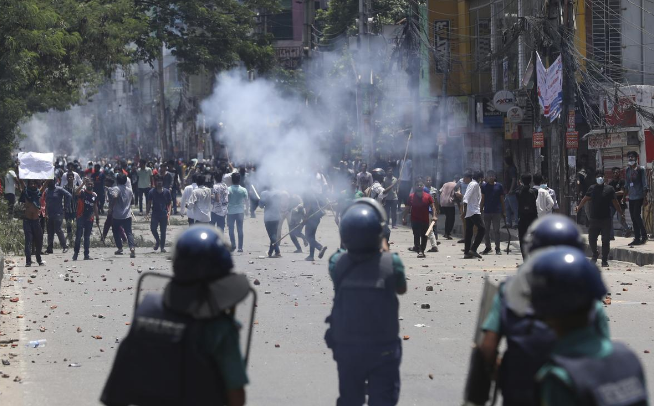Authorities in Bangladesh have imposed a nationwide curfew following deadly unrest that has spread across the country. Clashes between student protestors and police have led to the deaths of at least 105 people, as reported by AFP based on hospital counts. This unrest poses the toughest political challenge yet for Prime Minister Sheikh Hasina, the longest-serving leader in Bangladesh’s history.
Why The Protests?
University students across Bangladesh are calling for the job quota system to be reformed. Under the system, more than half of much sought-after government jobs are reserved.
The protests erupted after June 5 when the High Court ordered the reinstatement of the 30 percent quota reservation in Government jobs for descendants of veterans who fought in the Bangladesh war of independence from Pakistan in 1971.
“We are not against the quota system in general, but we want the 30 per cent quota for the descendants of 1971 freedom fighters to be abolished,” Nahid Islam, the coordinator of the anti-quota protests told Reuters. “Government jobs are the only hope for many young people in Bangladesh, and this quota system is depriving them of opportunities.”
Many of the protesters are also concerned about the accuracy of the list of veteran’s families, believing that some might unfairly benefit from the provision. They argue the quota is discriminatory, and should be replaced with a merit-based system. They also say it benefits supporters of Prime Minister Sheikh Hasina, whose Awami League party led the independence movement, reports Al Jazeera.
Bangladesh’s Job Quota System
As per reports from Al Jazeera, Bangladesh’s quota system reserves more than half of well-paid civil service posts, totalling hundreds of thousands of government jobs, for specific groups, including 30 percent reservation for children of fighters in the country’s 1971 war of independence from Pakistan.
The quota system has been in place since 1972 and was abolished by Hasina in 2018 as a result of student protests before the court brought it back in June.
The students argue the reserved jobs for veterans benefit a small group of people affiliated with the Awami League, which led the movement for independence.
Unemployment is rampant in Bangladesh, where 40 percent of youth are neither working nor in university.
What Fueled The Protests?

As per reports by Firstpost, during a press conference on Sunday, Hasina was asked about the student protests and the quota system. She responded by saying, “If the grandchildren of freedom fighters do not receive [quota] benefits, who would get it? The grandchildren of Razakars?”
“Razakar” is a derogatory term in Bangladesh, referring to those who collaborated with the Pakistani military during the 1971 Liberation War. It is considered a betrayal of their country.
The Bangladesh PM’s comments were considered derogatory by student protesters, further angering them.
On Sunday night, thousands of students marched through the Dhaka University campus chanting the slogan, “Who are you? Who are you? I am Razakar, I am Razakar.” It is an adaptation of the famous chat during the Liberation War, “Who are we? Bengali”, according to a report in Scroll.in.
On Monday, clashes broke out at Dhaka University between protesters and members of the student wing of the ruling Awami League party, the Bangladesh Chhatra League (BCL), leaving more than 100 students injured, police said.
Violence spread overnight to Jahangir Nagar University in Savar, outside Dhaka, and was reported elsewhere around the country on Tuesday, reports The Associated Press (AP).
At Jahangir Nagar University, demonstrators gathered in front of the vice-chancellor’s residence early Tuesday when they were attacked by BCL activists and police, say witnesses. Over 50 people were treated at a nearby hospital, with at least 30 suffering pellet wounds.
Abdullahil Kafi, a senior police official, told the country’s leading English-language newspaper, Daily Star, that protesters attacked police and that officers retaliated with tear gas and blank rounds. He said up to 15 police officers were injured. However, the protesters have accused the BCL and police of instigating the violence, reports AP.
Of the five reported deaths, one was in Dhaka and three others, including a pedestrian, in Chattogram. Media reports also said that a 22-year-old protester died in Rangpur.
On Wednesday, students will hold funerals in absentia across the country for victims of Bangladesh. They will march carrying coffins as a token protest, announced Asif Mahmud, a leader of the Student Movement Against Discrimination, reports bdnews24.
How Has the Government Responded?
As per reports by Frontline Magazine, in response to the escalating violence, the government has banned public rallies in Dhaka and imposed a nationwide internet blackout, according to NetBlocks. Authorities have also ordered the closure of all universities, which are the epicenters of the protests. Despite these measures, students have refused to vacate campuses, leading to deadly clashes with police. Police accuse protesters of burning and vandalizing buildings, including government and police offices.
What Are the Students’ Demands?
University students across Bangladesh are calling for a complete overhaul of the job quota system, arguing that it unfairly benefits Awami League supporters. With youth unemployment rates high, students believe the system exacerbates inequality and limits opportunities for those outside the ruling party’s influence. The movement, known as Students Against Discrimination, has seen thousands of participants from major universities like Dhaka University and Chittagong University, as per reports by Al Jazeera.
What Is the Historical Context of Student Protests in Bangladesh?
Bangladesh has a rich history of student protests, dating back to the Bhasha Andolan (language movement) of 1952, which played a crucial role in the country’s freedom struggle and the creation of Bangladesh. Today’s protests continue this legacy, with students once again at the forefront of demanding change.
How Are the Protests Organized?
According to Al Jazeera, the current movement is not backed by any political organization. Protesters, such as Fahim Faruki, a third-year international relations student at Dhaka University, state that the demonstrations were organized through a Facebook group, emphasizing the grassroots nature of the movement.
What Has Been the International Response?
International media have reported on the severity of the unrest and the government’s measures to control it. News agencies like AFP and Al Jazeera have documented the violence and the significant impact on the nation’s connectivity and communication infrastructure, with major news organizations’ websites remaining offline.
Will There Be a Resolution?
In a televised address, PM Sheikh Hasina invited students for talks to find a peaceful solution. However, given the current tensions and the students’ steadfast demands, it is uncertain whether the offer will be accepted.
What’s Next?
The government has been unable to quell protests. Experts have warned that the government’s heavy-handed response and failure to address the grievances of protesters could only lead to more anger and instability in the country, reports Firstpost
Asif Nazrul, a law professor at Dhaka University, criticised the government’s response, suggesting it was eager to suppress the protests and had found a convenient pretext, reports Al-Jazeera.
“The government needs to find a way to listen to the students’ concerns and find a fair solution to this quota issue,” Mohammad Abdur Razzaque, chairman of Research and Policy Integration for Development told Reuters. “Resorting to violence and labelling the protesters as anti-national forces is only going to exacerbate the situation and deepen the divisions in Bangladeshi society.”





